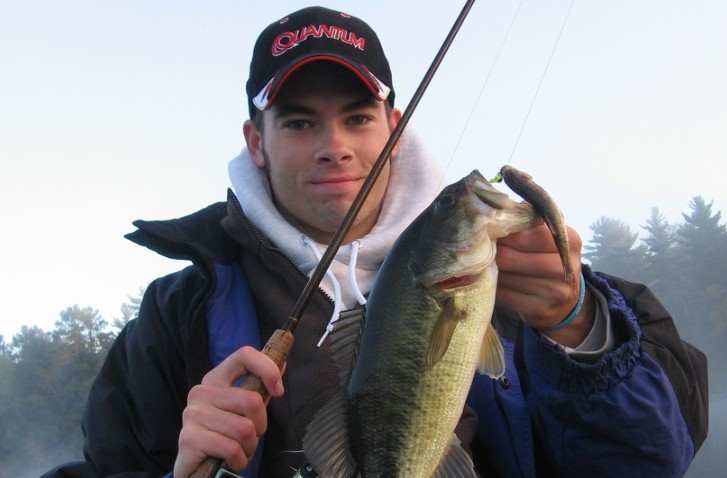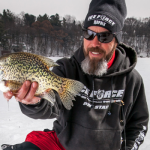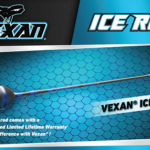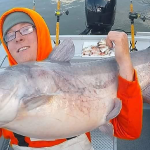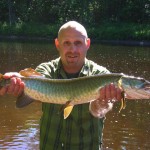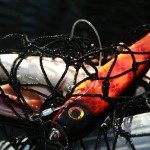By: Andrew Ragas
Most bass anglers will cringe at the concept of fishing with live bait, let alone the thought of ever using it. Putting the ego aside, as water temperatures at your favorite bodies of water cool down to below 50 degrees in mid to late fall, fishing with live bait is an excellent option for catching largemouth and smallmouth bass.
I was introduced to bass fishing at a young age by strictly live bait fishing. Until I learned how to successfully fish with artificial lures, it was the most effective way I’ve ever fished. To this day I still utilize live bait techniques when presented with the right opportunities for them. Fishing with live bait and the success that can be had with it isn’t a secret. When the fishing becomes difficult during the cold water period, anglers frequently turn to jigging and rigging for bass with live minnows.
Fish Behaviors
During the cold water period, the activity levels and feeding attitudes of fish may be anywhere from active and neutral to negative. Falling water temperatures slow down metabolic processes and fish activity decreases. In these situations, natural lakes offer anglers an opportunity to catch big late season bass.
There are several keys to understanding bass during the cold water period. The first is realizing that the combination of falling water temperatures and diminishing light levels, along with several other factors such as turnover and oxygen levels, stimulate bass to shift their locations into deeper water habitat areas in preparation for winter.
For instance, during the fall and wintering staging process, bass in natural lakes are usually concentrated around drop-off areas found at the ends of bars and flats that are close to the lake basins. Fish also seek out transition areas from harder to softer bottom, such as sunken islands and deep rock humps. A forage base near these areas is critical for sustaining fish.

Late Fall Locations
SMALLMOUTH BASS – The fall cold water period is a peak time for catching trophy smallmouths. I’ve found that the best deep water locations are typically found far away from shorelines and as close to the main lake basin as possible. For smallmouth bass, a long, shallow bar protruding far into the lake before dropping sharply into the lake basin is a prime location. The most productive drop-offs are those that are not entirely rock covered, but rather scattered rocks with a combination of sand and mud, and include several other transition points.
During fall, smallmouths spend considerable time near a lake’s basin, and as the season progresses, they make more consistent use of deeper water. The best smallmouth areas are usually in deeper water, but the most common basin depths they prefer seems to range anywhere from 25-60 feet.
LARGEMOUTH BASS – Cooling water temperatures cause largemouths to aggregate around any cover they can find. In most lakes, they move to steep sloping contours where they can frequently change depths. These areas are classic winter sanctuaries for large numbers of fish.
In fall, the shallowest habitat progressively becomes less suitable for largemouths. Fish that have been residing in shallow weeds during the summertime months transition first to shallow flats before eventually making their way over to cover found near drop-offs. Common areas are laydowns and weedlines, and depths may range from 15 to 40 feet. Green weed patches, usually found on drop-offs, are a giveaway late fall location for bass in natural lakes. It is important to note that not all weedgrowth dies off and decays at the same time, and those that remain alive and green throughout the cold water period concentrate fish the most.

Why Live Bait
When bass are in a neutral or negative feeding mood, a slow presentation produces more and bigger fish than a rapid retrieve. Live bait is meant to be fished slowly, but also possesses the added triggering effects of natural scent, profile, taste, and action. Live baits ranging in size from 3 to 6 inches are presented most effectively in deeper water where inactive fish are more likely to be found, and should be an option whenever encountered with difficult conditions.
The diversity of prey and the appetite of bass leads to great fishing opportunities with live bait. When fall fishing conditions are difficult such as cold fronts, wintery weather, high winds, or when fish are suspending, live bait is often the best method for attaining a good day’s catch.
Live bait is available in several shapes and sizes and include chubs, suckers, shad, shiners, and even juvenile panfish species such as young of the year bluegills and perch. Each possess differing triggering effects, and are best fished in their native lakes. In many waters, bass that are wary of lures often go for live bait that is presented in a natural way.

Gear and Techniques
Both largemouth and smallmouth bass occupy a wide range of fall habitat and forage on so many prey types that live bait fishing becomes diverse. Conventional rigs range from hooks and jigs tipped with bait to intricately balanced systems that involve floats, sinkers, swivels, beads, and leaders.
During the fall, I predominantly fish by three methods: Live bait rigs; Slip bobber rigs, and jigs.
Live bait rigs such as the famed legendary Lindy Rig are good for locating inactive bass in deep water while drift fishing. Rigged through the lips, my bait is used to slowly troll or drift along the bases of drop-offs and weedlines. The bullet weight or walking sinker should slip on the line and always make contact with the bottom. To improve their effectiveness and to potentially trigger more bites from lethargic fish, I sometimes add a flashy spinner just above the hook, and may even attach a small adjustable float to keep the bait hovering slightly above bottom. Live bait rigs are among the best when searching for fish because they allow for quick coverage, and are best fished with a controlled drift by utilizing a combination of the wind and your boat’s electric trolling motor.
A secondary option I like to use, which taught me how to bass fish and has caught several large fish for me in the past, is the slip bobber rig. These float rigs work great when drifting baits across flats, and when anchored or positioned along drop-offs and deep weedlines. The slip bobber rig is known more as a year-round big walleye producer when fish are on shallow structure and in cover, but it has its time and place with bass fishing as well. It is lethal when fish are suspended or want a vertical presentation. Best of all, it easily detects bites.
Finally, leadhead jigs are frequently used to cast either to cover or deep water, and fish best when bottom bouncing and vertical jigging is required. I use jigs ranging in size from a light 1/16 ounce size to a heavy ½ ounce size. Lighter jigs are for shallower water while heavier jigs are for deeper water. I fish jigs best by letting them sink to the bottom and then retrieving them with a gentle lift and popping manner as most strikes occur on the pause as it drops back down.
When fishing with live bait, I use tackle that is sensitive to detect light bites, but is also strong enough to pull fish up from the depths. It’s easiest to fish live bait on a medium to medium-heavy moderately fast action spinning rod and reel. I usually use a 7 foot Quantum Tour Edition rod in either action with a size 30 spinning reel spooled with limp, easy casting 8 lb. line. Some favorite lines for this style of fishing are P-Line Fluoroclear and Cortland Endurance.
How live bait is fished depends on the type of bottom and depth of water. When a fish hits, I normally let the fish run for a few seconds before setting the hook. By staying patient and ready with the hook set I ensure myself of a properly hooked fish rather than one that is either gut-hooked or difficult to release. Besides a timely hook set, another issue to keep in mind is that bass from the deep are prone to burst their swim bladders. This occurs during fast fights in which fish are rapidly pulled up from deep water. When fighting fish from the deep, always be sure to take your time, and gradually play it up to the boat so that damage is prevented, and the fish can be released to swim away.

Conclusion
When bass are active participants during your late fall excursion and are still interested in feeding, fishing with live bait can be a very exciting and refreshing break from fast paced lures and the ‘run and gun’ mentality that most serious bass anglers have.
With the different options of using naturally-caught and trapped prey fish, or store-bought bait fish, matching the hatch has never been as easy like this for bass fishing in the fall.



